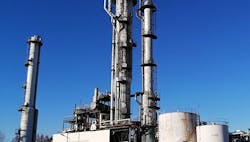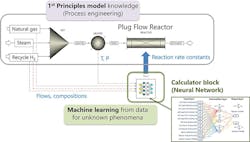Novel Approach Improves Ammonia Process Efficiency
Ammonia is one of the most important products in the global fertilizer industry, with applications also in pharmaceuticals, textiles, cleaning products, wastewater treatment and more. With the surge of interest in hydrogen as a fuel, ammonia has gained attention as an easily transportable way to store and reconvert hydrogen for applications such as fuel cells for cars.
While there is research focused on green ammonia produced by electrolysis and powered by renewable energy, the conventional ammonia production process uses natural gas through steam methane reforming. The process is highly energy intensive and significantly impacts carbon emissions worldwide. Therefore, a strong incentive exists to improve energy and resource efficiency in the manufacture of ammonia to reduce the environmental footprint. This is incredibly important as asset-intensive industries, and the rest of the world, strive to achieve net-zero emissions. (For details on some current efforts, see “Collaboration Promises a Winning Hand,” and “Net Zero Efforts Add Up.”
Reducing Environmental Impact
Nissan Chemical Corp., founded in 1887, was the first chemical fertilizer company in Japan. It currently has five manufacturing sites in Japan that produce a wide range of chemicals, performance materials, agricultural chemicals and pharmaceuticals.
Nissan Chemical’s philosophy is to contribute to society with superior technology, products and services, while striving for harmony with the environment. This is our main driver for lessening the impact of current operations, including the manufacture of ammonia.
The company was looking to decrease costs and improve energy consumption in the ammonia process at its plant in Toyama. This site currently produces ammonia and derivatives using natural gas, having switched from its previous reliance on coal, fuel oil and naphtha as sources. In 2005, we established a production and supply system for high quality urea for use in AdBlue, a solution of urea in demineralized water that serves as an operating fluid in diesel-powered trucks to improve emissions.
During ammonia manufacture, sulfur is removed from the natural gas to prevent catalyst damage in the reactor. The natural gas then goes through a reformer, where the reaction with steam produces hydrogen and carbon monoxide (CO). The CO then is converted to carbon dioxide (CO2), which is removed before it can go through the ammonia synthesis process. Capturing, utilizing and storing the CO2 is an essential step to deliver offsets needed to achieve net-zero targets through blue ammonia manufacture.
Partnering To Improve Reactor
To increase the efficiency of the process, we determined that step number one would be to identify performance gaps at the reformer reactor. However, conventional rigorous reactor modeling requires an accurate temperature profile of the process fluid. The difficulty in measuring or estimating the temperature distribution in the furnace limited the application of a pure first principles simulation approach.
To address this challenge, Nissan Chemical approached AspenTech in early 2021 to develop a model based on Aspen Hybrid Models technology [1]. AspenTech develops asset optimization software and Nissan Chemical is an active user of its engineering tools, including process simulation and optimization software Aspen Plus. With the launch of Aspen Hybrid Models in October 2020 and the release of aspenONE V12.1 in May 2021, both companies identified the opportunity to leverage these technologies to help improve Nissan Chemical’s operations.
Figure 1. A neural network to calculate kinetic parameters augments a first principles model.
With Aspen Hybrid Models, AspenTech uses machine learning (ML) to enhance the first principles knowledge captured in digital tools built on 40 years of experience. This allows engineers to:
• represent real plant behavior with models created from operational data and first principles constraints;
• create high fidelity models that can be used for rapid and accurate decisions in engineering and operations; and
• recalibrate models to changing process conditions more easily with artificial intelligence (AI)/ML.
To solve the modeling problem and improve the efficiency of the ammonia manufacturing process, Nissan Chemical and AspenTech collaborated to develop a First Principles Driven Hybrid Model of the reactor. This is an Aspen Hybrid Model that combines first principles modeling and ML, via neural networks, to capture unknown or unmeasurable details of phenomena in the plant. The first principles model framework ensures the results obey engineering fundamentals of material balance, energy balance, etc.; ML allows for a higher fidelity match with plant operating data. The technology is native to process simulators Aspen Plus and Aspen HYSYS, making it possible for the neural networks to tune existing process models to reality.
Improving The First Principles Models
The steam reforming reactor is modeled in Aspen Plus and improved using AI-enabled calibration embedded within the process simulator. Figure 1 depicts the final flowsheet. The top of the figure shows the equipment blocks used to model the process. These are the same as those in a conventional model using first principles knowledge. The AI technology is embedded in the calculator block on the lower half of the image. In this calculator block, a neural network performs the calculation of the kinetic parameters.
Creating the hybrid model involved a simple five-step methodology:
1. model creation in Aspen Plus using standard flowsheeting techniques;
2. data analysis and conditioning;
3. definition of the hybrid model;
4. training of the hybrid model; and
5. deployment of the predictive model in the flowsheet.
The model created in Aspen Plus represented the reactor model and the steam reforming and water gas shift reactions taking place. Kinetics data in the literature served as a starting point for the reaction rates.
As part of the process, and to overcome concerns about data quality, data had to be cleaned thoroughly before feeding to the neural network for training; data points with material imbalances greater than 2% were removed.
The cleaned data then were used to train a neural network and predict reaction rates from feed temperatures, pressures, rates and compositions. The ML algorithms adjusted the neural net parameters to best match the reactor outlet conditions. Building a model from fully conditioned data took less than a day.
The Impact On Energy Efficiency
Using Aspen Hybrid Models, we created a calibrated model in 2021 that could reproduce real plant data more accurately than the conventional, kinetic-based reformer model — and twice as fast.
Unlike a conventional modeling approach, where the reaction kinetics expression must be known or hypothesized before tuning parameters, the ML algorithm learns how to predict the reactor performance from the available operating data. This results in a much more efficient workflow and enables easy recalibration to new operating conditions. An added advantage is that the resultant model typically is more accurate over a wider range of conditions.
With this First Principles Driven Hybrid Model, we evaluated steam requirements and identified the potential to reduce steam input up to 2% in the Toyama plant, thus helping us to align with our philosophy to strive for harmony with the environment by reducing the negative impact of operations. We have shared the recommendations with the control engineers at the plant to update the plant operating parameters.
To further optimize its ammonia production, Nissan Chemical is looking to extend the use of Aspen Hybrid Models to other unit operations and, eventually, to other processes.
TAKUTO NAKAI is a chemical engineer in the production department of the Toyama, Japan, plant of Nissan Chemical Corp. Email him at [email protected].
REFERENCE
1. Nakai, T., “Rapid and Accurate Steam Reformer Model Development to Improve Efficiency Using First Principles Driven Hybrid Models,” presented at AspenTech OPTIMIZE 21 (May 2021).

